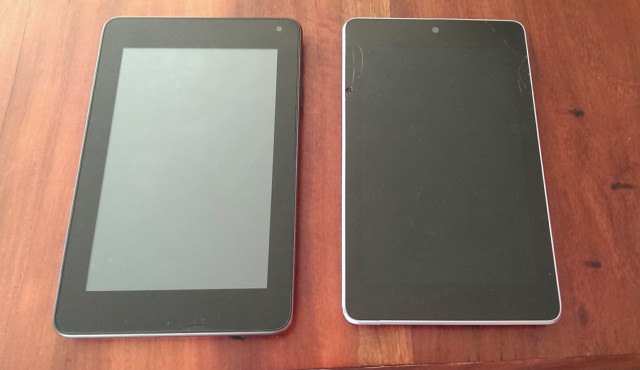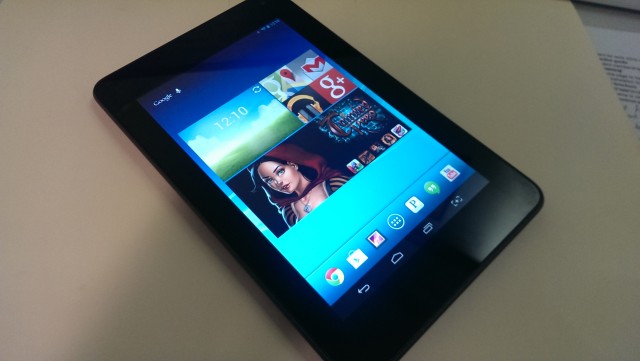Hisense’s first foray into the tablet market, the Sero 7 Pro, is very similar to last year’s Nexus 7 in looks and specifications – a 7-inch tablet running NVIDIA’s Tegra 3 system-on-a-chip inside its minimalistic black glass front and soft-touch plastic rear. I received a review unit directly from Hisense yesterday, and after spending yesterday with the tablet, I have some initial thoughts that I’d like to share with y’all. Let’s start with the specifications – a very good place to start:
- NVidia Tegra 3 system-on-a-chip
- 7-inch 1280×800 IPS LCD display
- 8 GB storage, with microSD card expansion up to 32 GB
- 1 GB RAM
- Android 4.2.1
- 5 MP rear camera with flash, 2 MP front-facing camera
- 802.11a/b/g/n Wi-Fi, Bluetooth 3.0 + EDR, NFC
- Mini-HDMI video output
- Battery 4000 mAh built-in lithium-ion battery
- 199.8 x 125.8 x 10.8mm, 360g
Anyone who owns a 2012 Nexus 7 will know just how the Tegra 3 performs, and I don’t expect to find too much performance difference between the two devices, although the Sero actually feels a lot faster than the Nexus 7 at the moment. This could be because it’s a brand-new device that’s not filled with 12 months’ worth of old applications and associated data, but we will see whether the Sero will grind to a halt like the Nexus did before being upgraded to Android 4.3.
Software
The Sero 7 Pro comes with Android 4.2.1 out of the box. It’s a couple of versions behind AOSP, but honestly, it’s not that big a deal. Especially considering that Hisense have made very few modifications to the Android experience, recognising that they’re not a software company, and opting not to ruin their device with bloaty applications and a poorly-considered UI skin.
That said, I’ve been able to find three changes from AOSP so far –
- Hisense have built a custom launcher that mixes elements of the old (pre-Jelly Bean)10-inch tablet launcher in with the standard tablet launcher. The effect isn’t too bad and it didn’t come at the expense of performance, so I have no problem with it at this stage.
- A fourth button has been added to the navigation bar to take screenshots easier. It’s probably going to be helpful for this review, but I don’t know that the one button-press that it saves will be worth the annoyance of the other buttons being misaligned.
- The device has been outfitted with power-saving settings that control the maximum frequency of the CPU. There are three modes – performance, balanced and power save. By default, the device is set to performance mode, but I’ll test out the different modes more thoroughly in the full review.
Apart from the Google suite of applications, there are only a handful of pre-loaded applications on the device as well, and all of them (except Tegra Zone for some reason) can be uninstalled, including Hisense’s own TV remote app. Pre-loaded on the device are Facebook, Pandora, Kingsoft Office, Hisense’s TV Remote and NVIDIA Tegra Zone. Honestly, the software on the Sero 7 Pro is the closest I’ve ever seen to pure Android on a non-Nexus or Google Play Edition device, and I appreciate it.
Hardware
I’ve mentioned that the Sero 7 Pro looks quite like a Nexus 7, but there are actually several noticeable differences. Firstly, the Sero is a little thicker than the Nexus, and quite a bit heavier – 0.24mm thicker, and 20g heavier, to be precise – but that’s not necessarily a bad thing. The added heft gives the tablet a much sturdier feeling than the Nexus 7, but it’s not uncomfortable to hold in your hand for extended periods of time.
The Sero has a microSD card slot on the top edge, which supports up to 32 GB, which unfortunately you may need, as the device only comes in an 8 GB flavour. Also up top are mini-HDMI, micro-USB and 3.5mm audio jacks.
Conclusion so far
I really like the Sero 7 Pro so far. The Nexus 7 was my favourite tablet of all time, and Hisense have done a great job building a sturdier-feeling version. I don’t mind the added heft – I prefer the HTC One over the Galaxy S 4 largely because it feels like I’m holding something solid – and as long as the performance keeps up, I can see myself really liking this device. Unfortunately though, it’s built with last year’s technology, and if it can’t compete with the Nexus 7 on price, it won’t be a success. Stay tuned for the full review in a couple of weeks.









This is a lovely little machine. By far the best of the four android devices we have in the house. The me facing camera is nice and clear as are the Skype conversations I have had so far. Need for Speed and Real racing run silky smooth. It is a little pocket rocket. My only niggles are about the Android Jellybean operating system. “Move app to SD” has been removed so once you fill the 8g on board (which I did in 4 hours) , that’s it. To install more apps you will need to remove something. The other is… Read more »
I have one of these that I bought from JB Hifi for $197. I’m liking it so far and with the Tegra 3 chipset it was a standout for the sub 200 bucks market.
That Nexus 7 has had a hard life.
Eh, if it’s dirt cheap. Perhaps.